Photo Section
As a 17-year-old, in 1976 I completed the 80-km Karoo Marathon in the town of Laingsburg in 7 h 19 min 48 sec. Long-distance running has always been a favourite sport of mine.

My father, Koos Stadler, was a minister of the church and a man of the veld.

My father, Koos, and mother, Riegie, visited me at Omega in the Eastern Caprivi. At that time I was a lieutenant in 31 Battalion’s reconnaissance wing.

The headquarters of 31 Battalion’s C Company.

Xivatcha Shekambe, scout extraordinaire, on roll-call parade. Xivatcha taught me much about the bush during my time at Omega.

Two senior Bushman soldiers of 31 Battalion’s reconnaissance wing. On the left is Tango Naca, with whom I often deployed.

Bushman soldiers on the basic parachute course at 1 Parachute Battalion in Bloemfontein. The course proved to be challenging for most members of the recce wing.

31 Battalion’s recce wing on the runway at Omega prior to deployment. From left to right: Tinus “Putty” van der Merwe, Steven Steinhobel, Charles Henning, Jorrie Jordaan, Neil Reinolds, Gerhard Nel (behind), Frik Theron, me and Xivatcha Shekambe. Mark Templeton is seated in front.

As a lieutenant with 31 Battalion. Even then I only wanted to do one thing – reconnaissance.

A sketch of an operator with Afro wig and SWAPO hat as disguise. SWAPO uniforms and blackened faces were standard during clandestine missions.

Frans Gunther commanded 31 Battalion’s C Company and was infamous for his drooping moustache when something wasn’t to his liking.

The lecture room at Fort Vreeslik near Omega where 31 Battalion’s recce wing did their training and prepared for operations. This was where the “roaring lions” incident took place.

In a playful tussle with Tinus “Putty” van der Merwe (right) at Omega.

The bar at Fort Vreeslik.

My sketch of a FAPLA early warning post in an old farmhouse near Mpupa in southeastern Angola. Annotations were done in code and later (during the debriefing) drawn in on the sketch.


Candidates were tested on both a physical and psychological level during Special Forces selection. The image below shows two of the doctors on my selection course (the man in the middle and the one on his knees).

Typical accommodation on the Special Forces’ Bushcraft, Tracking and Survival course.

Setting traps and snares was part of the daily routine on the survival course in the Caprivi.

Visitors to the Small Team headquarters at 5 Reconnaissance Regiment at Phalaborwa were welcomed by this emblem at the entrance. Later the official badge depicted Joshua and Caleb (pictured below), two spies sent out by Moses, under a Southern Cross.


With members of 5 Recce during my first Small Teams exercise in the valleys of the Blyde River Canyon. From left to right are Corn? Vermaak (intelligence officer), me, and operators Jos? dos Santos (back), CC Victorino (front) and Jo-Jo Bruyns.

The “mean team” from 5 Recce were, from left to right, CC Victorino, Neves Matias, Dave Scales, Boet Swart and Andr? Diedericks.

Small Team operators Andr? Diedericks with his buddy Neves Matias and me with my buddy Jos? da Costa, alias “Mr T”

Andr? Diedericks at Ondangwa prior to a deployment. His pack weighed in at 94 kg.

The Small Team members during Operation Cerberus: from left to right are me, CC Victorino, Neves Matias and Andr? Diedericks. Note the camouflaged BRDM-2 armoured vehicle with SA-9 missile system behind us.


Two sketches I made of the ingenious methods used by UNITA soldiers to get our vehicles up and running again. The top image illustrates how they recovered the BRDM/SAM-9 after a breakdown, while the bottom one is of the improvised jack they made when the vehicle had a flat tyre.

My friend and legendary Small Team operator Andr? “Diedies” Diedericks. Note the two Honoris Crux medals on his left chest.

Andr? Diedericks and Neves Matias after they were awarded the Honoris Crux silver and bronze respectively.

The famous five-course meal served to Small Team operators after a deployment. From left to right: Graig Trethewy (second from left), Dave Scales, Neves Matias, Col. Terence Murphy, Boet Swart. My back is to the camera.

A Small Team operator’s personal equipment. All items were secured to the chest webbing with a string.

The Small Team operators who took part in Operation Caudad in May 1986. At the back are Jo-Jo Bruyns, Dave Scales and Andr? Diedericks. In front are me and CC Victorino.

In the helicopter before take-off for Operation Caudad to Zimbabwe. On my left is sergeant-major Eddie Edwards.

Operation Caudad was aimed at conducting pre-emptive stikes at ANC facilities in the so-called frontline states. Our mission to Harare, during which two ANC offices were attacked, caused an international uproar. This headline is from the Pretoria News.

TCC Victorino and me during Operation Killarney in December 1985. Our goal was to disrupt the railway line that was also FAPLA and SWAPO’s supply line between the harbour town of Namibe and Lubango in the interior.

Neves Matias, Jos? da Costa and CC Victorino formed a combined team after I injured myself during Operation Killarney. This photo was taken back at the landing zone – note the empty backpacks.

A train on the Namibe-Lubango railway line – this shot was taken from one of the team’s observation posts near the town of Caraculo.

I took this photo of the railway line at Caraculo, stretching east towards the Serra de Leba mountains, when I visited the area in 2002.

Our “guesthouse” at a UNITA forward base during Operation Abduct 1 in early 1987. Our aim was to bring an end to FAPLA’s air superiority in southern Angola by blowing up MiGs at the air base at Menongue.

Prior to deployment on Operation Abduct 1: Andr? Diedericks, a UNITA liaison officer (standing), Neves Matias (sitting in the doorway), Daves Scales (in civvies), me, and our UNITA contact known to us only as “Captain Mickey”.

The Kw?vo?l en route to the forward UNITA temporary base during Operation Abduct 1.
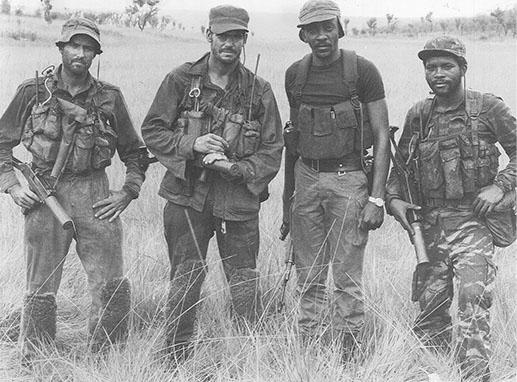
With Andr? Diedericks (second from left), UNITA’s Captain Mickey and Neves Matias during Operation Abduct 1. Note the sheepskin padding on the operators’ knees.

Small Team operator Jos? da Costa points to the position of the cache during Operation Abduct 2.
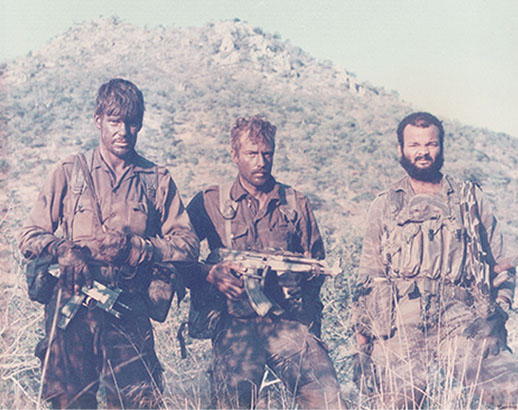
The team back at the landing zone: Andr? Diedericks, me and Da Costa.
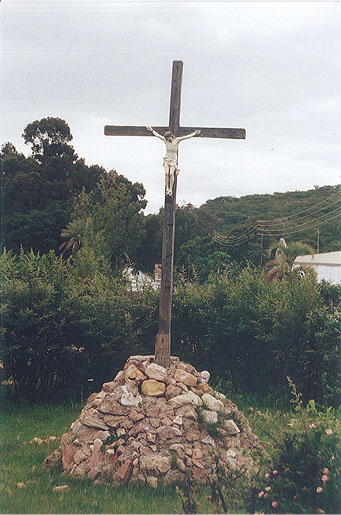
This wooden cross was still at the mission station, near the town of Huila, in 2002. During Operation Abduct 2 in 1987 we passed this cross during our infiltration of the target area.
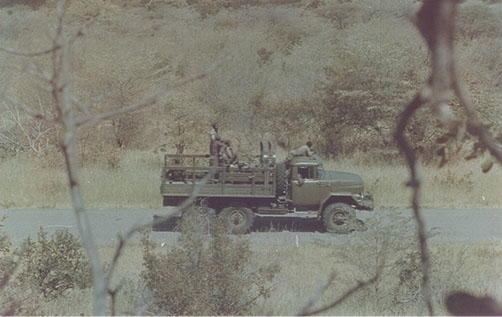
This shot of an MPLA Ural truck was taken from an observation post during Operation Abduct 2.
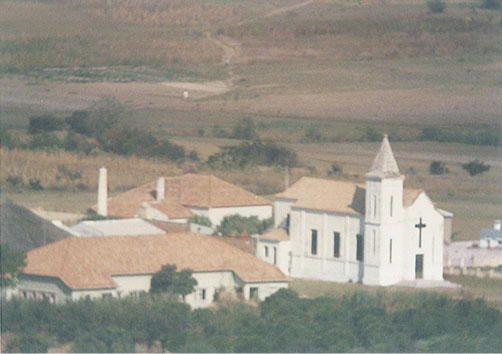
This photo of the church at Huila was taken from one of our observation posts. We had to pass the settlement to get to the air base at Lubango.

The same church in 2002.

My sketch of the target area during Operation Abduct 2, made in a pigskin notebook, which ensures that the drawings stay intact when exposed to water or adverse conditions.
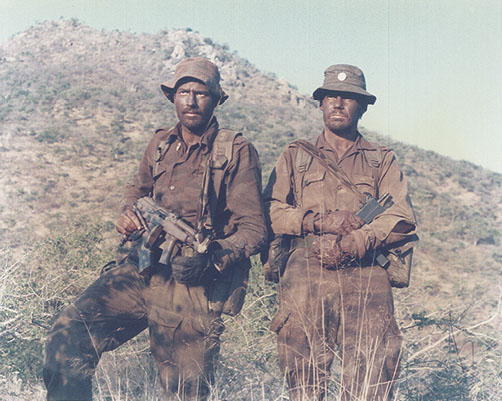
Andr? Diedericks and me at the landing zone just before we were picked up after Operation Abduct 2.
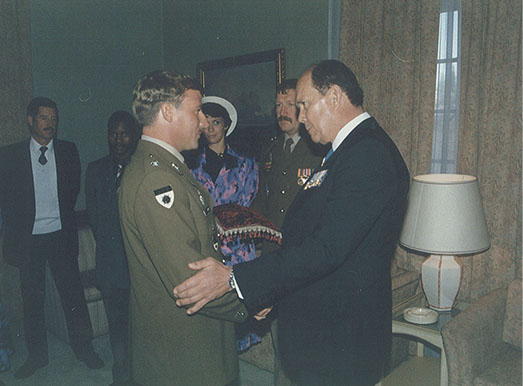
Receiving the Honoris Crux (bronze) from then Minister of Defence Magnus Malan.

The citation for the Honoris Crux I received for “several highly dangerous and top-secret operations” conducted “deep behind enemy lines”.

When I noticed this photo in an album, I simply knew I had to meet the girl. Karien subsequently became my wife.

With my wife, Karien, and our twins, Kobus and Karlia, on a dune in the Rub’ Al-Khali desert in Saudi Arabia where I was stationed as Defence Attach? between 2007 and 2011.
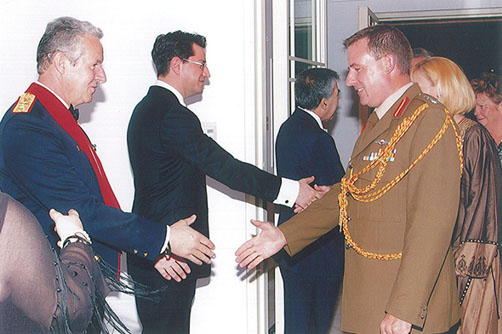
Greeting the Greek Defence Attach? at a reception during my time as Defence Attach? in Saudi Arabia.
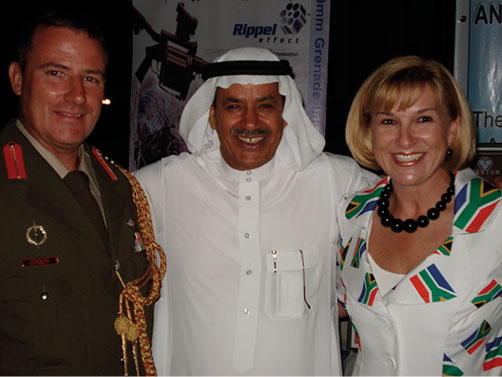
My wife, Karien, and our friend General Abdullah Al-Sadoun.






